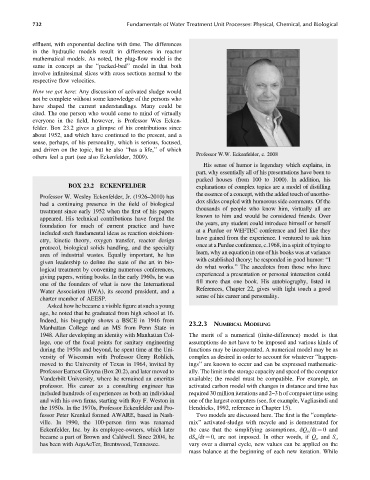Page 777 - Fundamentals of Water Treatment Unit Processes : Physical, Chemical, and Biological
P. 777
732 Fundamentals of Water Treatment Unit Processes: Physical, Chemical, and Biological
effluent, with exponential decline with time. The differences
in the hydraulic models result in differences in reactor
mathematical models. As noted, the plug-flow model is the
same in concept as the ‘‘packed-bed’’ model in that both
involve infinitesimal slices with cross sections normal to the
respective flow velocities.
How we got here: Any discussion of activated sludge would
not be complete without some knowledge of the persons who
have shaped the current understandings. Many could be
cited. The one person who would come to mind of virtually
everyone in the field, however, is Professor Wes Ecken-
felder. Box 23.2 gives a glimpse of his contributions since
about 1952, and which have continued to the present, and a
sense, perhaps, of his personality, which is serious, focused,
and driven on the topic, but he also ‘‘has a life,’’ of which
Professor W.W. Eckenfelder, c. 2008
others feel a part (see also Eckenfelder, 2009).
His sense of humor is legendary which explains, in
part, why essentially all of his presentations have been to
packed houses (from 100 to 1000). In addition, his
BOX 23.2 ECKENFELDER explanations of complex topics are a model of distilling
the essence of a concept, with the added touch of unortho-
Professor W. Wesley Eckenfelder, Jr. (1926–2010) has
dox slides coupled with humorous side comments. Of the
had a continuing presence in the field of biological
thousands of people who know him, virtually all are
treatment since early 1952 when the first of his papers
known to him and would be considered friends. Over
appeared. His technical contributions have forged the
the years, any student could introduce himself or herself
foundation for much of current practice and have
at a Purdue or WEFTEC conference and feel like they
included such fundamental ideas as reaction stoichiom-
have gained from the experience. I ventured to ask him
etry, kinetic theory, oxygen transfer, reactor design
once at a Purdue conference, c.1968, in a spirit of trying to
protocol, biological solids handling, and the specialty
learn, why an equation in one of his books was at variance
area of industrial wastes. Equally important, he has
with established theory; he responded in good humor: ‘‘I
given leadership to define the state of the art in bio-
do what works.’’ The anecdotes from those who have
logical treatment by convening numerous conferences,
experienced a presentation or personal interaction could
giving papers, writing books. In the early 1960s, he was
fill more than one book. His autobiography, listed in
one of the founders of what is now the International
References, Chapter 22, gives with light touch a good
Water Association (IWA), its second president, and a
sense of his career and personality.
charter member of AEESP.
Asked how he became a visible figure at such a young
age, he noted that he graduated from high school at 16.
Indeed, his biography shows a BSCE in 1946 from
23.2.3 NUMERICAL MODELING
Manhattan College and an MS from Penn State in
1948. After developing an identity with Manhattan Col- The merit of a numerical (finite-difference) model is that
lege, one of the focal points for sanitary engineering assumptions do not have to be imposed and various kinds of
during the 1950s and beyond, he spent time at the Uni- functions may be incorporated. A numerical model may be as
versity of Wisconsin with Professor Gerry Rohlich, complex as desired in order to account for whatever ‘‘happen-
moved to the University of Texas in 1964, invited by ings’’ are known to occur and can be expressed mathematic-
Professor Earnest Gloyna (Box 20.2), and later moved to ally. The limit is the storage capacity and speed of the computer
Vanderbilt University, where he remained an emeritus available; the model must be compatible. For example, an
professor. His career as a consulting engineer has activated carbon model with changes in distance and time has
included hundreds of experiences as both an individual required 30 million iterations and 2–3 h of computer time using
and with his own firms, starting with Roy F. Weston in one of the largest computers (see, for example, Vagliasindi and
the 1950s. In the 1970s, Professor Eckenfelder and Pro- Hendricks, 1992, reference in Chapter 15).
fessor Peter Krenkel formed AWARE, based in Nash- Two models are discussed here. The first is the ‘‘complete-
ville. In 1990, the 100-person firm was renamed mix’’ activated-sludge with recycle and is demonstrated for
Eckenfelder, Inc. by its employee-owners, which later the case that the simplifying assumptions, dQ o =dt ¼ 0 and
became a part of Brown and Caldwell. Since 2004, he dS o =dt ¼ 0, are not imposed. In other words, if Q o and S o
has been with AquAeTer, Brentwood, Tennessee. vary over a diurnal cycle, new values can be applied on the
mass balance at the beginning of each new iteration. While

